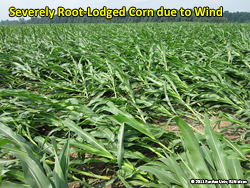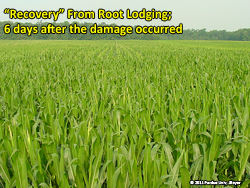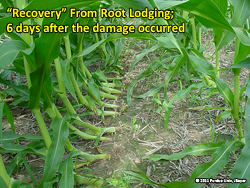29 July 2011
URL: http://www.kingcorn.org/news/articles.11/FlatCorn-0728.html
An Example of "Recovery" From Severe Root-Lodging
R.L. (Bob) Nielsen
Agronomy Dept., Purdue Univ.
West Lafayette, IN 47907-2054
Email address: rnielsen
at purdue.edu
![]() thunderstorm with strong winds flattened hundreds of acres in eastern Indiana late in the afternoon of 22 July as a result of plants being partially uprooted. The appearance of damaged fields the morning after was demoralizing to growers and casual observers alike.
thunderstorm with strong winds flattened hundreds of acres in eastern Indiana late in the afternoon of 22 July as a result of plants being partially uprooted. The appearance of damaged fields the morning after was demoralizing to growers and casual observers alike.
However, because many of these fields were planted extremely late due to a wet planting season, the plants were still in the late vegetative phase of development (1 to 2 weeks before tasseling) and, most importantly, still in the process of stalk elongation. Root-lodged stalks that are still elongating can respond to such root-lodging by slowly bending or "goose-necking" in an attempt to regain an upright stance. Such "goose-necking" is the result of changes in the distribution of plant growth hormones in the stalk tissue that cause more rapid elongation on the bottom side of the nearly horizontal stalks than on the top side.
As long as root damage caused by the lodging is not extreme and there is adequate soil moisture to foster additional root development during the recovery period, flattened fields of corn at these growth stages can "recover" fairly well. I put the word "recover" in quotes because severely root-lodged fields will usually not recover completely. However, if the damaged plants can goose-neck sufficiently and quickly enough by the time the field moves into the critical tassel/silk pollination period such that the portion of the stalk containing the silked ears is again upright, then pollination will likely be successful.
The three photos accompanying this article are from a 30-acre field at the Davis-Purdue Ag Center in Randolph County. The storm moved through the area late in the afternoon of 22 July and severely flattened hundres, if not thousands, of corn acres in the area. The field had been planted 3 June, much later than desired because of the frustratingly late, wet planting season. However, the good news was that plant development was consequently delayed relative to the calendar and the field was still about one week away from tasseling and pollination. I say "good news" because the plants were still in their rapid growth phase with stalks still rapidly elongating.
The first photo shows the appearance of the damaged field the morning after the storm. I estimated 80-90% of the plants were root-lodged and nearly flat to the ground. The second photo shows the same field six days late on 28 July and the change in appearance is amazing. Dramatic bending of the horizontal lower stalk tissue resulted in "goose-necked" plants and, more importantly, enough upright growth to place the silking ears in a position to be exposed to pollen from the tassels.
Time will tell to what extent yield will be decreased and, unfortunately, there is no good comparison to even determine how much yield will be lost. With the hope that weather conditions during grain filling improves, the next big challenge will be harvesting the crop because of the difficulty of moving the combine header through the yet root-lodged lower portions of the crop canopy.
Related reading
Nielsen, RL (Bob) Nielsen. 2011. Prospects of Recovery for Root-Lodged Corn. Corny News Network, Purdue Univ Extension. [online] Available at http://www.kingcorn.org/news/articles.11/FlatCorn-0726.html [URL accessed July 2011].




